Solar eclipse of August 21, 1914
A total solar eclipse occurred at the Moon's descending node of orbit on Friday, August 21, 1914,[1] with a magnitude of 1.0328. A solar eclipse occurs when the Moon passes between Earth and the Sun, thereby totally or partly obscuring the image of the Sun for a viewer on Earth. A total solar eclipse occurs when the Moon's apparent diameter is larger than the Sun's, blocking all direct sunlight, turning day into darkness. Totality occurs in a narrow path across Earth's surface, with the partial solar eclipse visible over a surrounding region thousands of kilometres wide. Occurring about 2.7 days before perigee (on August 24, 1914, at 6:30 UTC), the Moon's apparent diameter was larger.[2]
The totality of this eclipse was visible from northern Canada, Greenland, Norway, Sweden, Russian Empire (the parts now belonging to Åland, Finland, Estonia, Latvia, Lithuania, Belarus, Ukraine and Russia, including cities of Riga, Minsk, Kiev and northeastern part of Vilnius), Ottoman Empire (the parts now belonging to Turkey, northeastern tip of Syria and northern Iraq), Persia and British Raj (the parts now belonging to Pakistan and western tip of India). A partial eclipse was visible for parts of northeast North America, Europe, North Africa, East Africa, and the Middle East. It was the first of four total solar eclipses that would be seen from Sweden during the next 40 years. This total solar eclipse occurred in the same calendar date as 2017, but at the opposite node.
Several astronomers were setting up to observe the eclipse, in part as an attempt to confirm Albert Einstein's theory of general relativity. However, due to the onset of World War I as well as cloud cover, these experiments were unsuccessful.
Observations
A number of observatories sent expeditions to Russia to observe the eclipse including those from Argentina, the United Kingdom, Germany, Russia, and the United States. The expeditions led by Charles Dillon Perrine of the Argentine National Observatory, Erwin Finlay-Freundlich of the Berlin-Babelsberg Observatory, Germany, and William W. Campbell of the Lick Observatory, California, included in their programs the second attempt to verify the general relativity theory of Albert Einstein. (Perrine had made the first attempt at the 1912 solar eclipse in Brazil.[3]) However, World War I broke out and Freundlich and his equipment were interned in Russia, unable to carry out the necessary measurements. C. D. Perrine and W. W. Campbell, from neutral countries, Argentina and the United States, were permitted to continue with their plans, but clouds obscured the eclipse.[3][4] Perrine was able to obtain one photograph of the eclipse but the thin cloud cover was enough to obscure star locations necessary to test Einstein's theory.[5]
Eclipse details
Shown below are two tables displaying details about this particular solar eclipse. The first table outlines times at which the moon's penumbra or umbra attains the specific parameter, and the second table describes various other parameters pertaining to this eclipse.[6]
| Event | Time (UTC) |
|---|---|
| First Penumbral External Contact | 1914 August 21 at 10:12:09.6 UTC |
| First Umbral External Contact | 1914 August 21 at 11:25:24.7 UTC |
| First Central Line | 1914 August 21 at 11:26:20.7 UTC |
| First Umbral Internal Contact | 1914 August 21 at 11:27:17.1 UTC |
| Equatorial Conjunction | 1914 August 21 at 11:55:06.4 UTC |
| Ecliptic Conjunction | 1914 August 21 at 12:26:24.1 UTC |
| Greatest Eclipse | 1914 August 21 at 12:34:27.1 UTC |
| Greatest Duration | 1914 August 21 at 12:34:52.8 UTC |
| Last Umbral Internal Contact | 1914 August 21 at 13:41:59.4 UTC |
| Last Central Line | 1914 August 21 at 13:42:58.0 UTC |
| Last Umbral External Contact | 1914 August 21 at 13:43:56.1 UTC |
| Last Penumbral External Contact | 1914 August 21 at 14:56:55.9 UTC |
| Parameter | Value |
|---|---|
| Eclipse Magnitude | 1.03276 |
| Eclipse Obscuration | 1.06658 |
| Gamma | 0.76546 |
| Sun Right Ascension | 09h59m08.5s |
| Sun Declination | +12°18'56.8" |
| Sun Semi-Diameter | 15'48.7" |
| Sun Equatorial Horizontal Parallax | 08.7" |
| Moon Right Ascension | 10h00m29.2s |
| Moon Declination | +12°59'43.6" |
| Moon Semi-Diameter | 16'09.7" |
| Moon Equatorial Horizontal Parallax | 0°59'18.8" |
| ΔT | 16.7 s |
Eclipse season
This eclipse is part of an eclipse season, a period, roughly every six months, when eclipses occur. Only two (or occasionally three) eclipse seasons occur each year, and each season lasts about 35 days and repeats just short of six months (173 days) later; thus two full eclipse seasons always occur each year. Either two or three eclipses happen each eclipse season. In the sequence below, each eclipse is separated by a fortnight.
| August 21 Descending node (new moon) | September 4 Ascending node (full moon) |
|---|---|
 |  |
| Total solar eclipse Solar Saros 124 | Partial lunar eclipse Lunar Saros 136 |
Related eclipses
Eclipses in 1914
- An annular solar eclipse on February 25.
- A partial lunar eclipse on March 12.
- A total solar eclipse on August 21.
- A partial lunar eclipse on September 4.
Metonic
- Preceded by: Solar eclipse of November 2, 1910
- Followed by: Solar eclipse of June 8, 1918
Tzolkinex
- Preceded by: Solar eclipse of July 10, 1907
- Followed by: Solar eclipse of October 1, 1921
Half-Saros
- Preceded by: Lunar eclipse of August 15, 1905
- Followed by: Lunar eclipse of August 26, 1923
Tritos
- Preceded by: Solar eclipse of September 21, 1903
- Followed by: Solar eclipse of July 20, 1925
Solar Saros 124
- Preceded by: Solar eclipse of August 9, 1896
- Followed by: Solar eclipse of August 31, 1932
Inex
- Preceded by: Solar eclipse of September 8, 1885
- Followed by: Solar eclipse of August 1, 1943
Triad
- Preceded by: Solar eclipse of October 20, 1827
- Followed by: Solar eclipse of June 21, 2001
Solar eclipses of 1913–1917
This eclipse is a member of a semester series. An eclipse in a semester series of solar eclipses repeats approximately every 177 days and 4 hours (a semester) at alternating nodes of the Moon's orbit.[7]
The partial solar eclipses on April 6, 1913 and September 30, 1913 occur in the previous lunar year eclipse set, and the solar eclipses on December 24, 1916 (partial), June 19, 1917 (partial), and December 14, 1917 (annular) occur in the next lunar year eclipse set.
| Solar eclipse series sets from 1913 to 1917 | ||||||
|---|---|---|---|---|---|---|
| Descending node | Ascending node | |||||
| Saros | Map | Gamma | Saros | Map | Gamma | |
| 114 | August 31, 1913 Partial | 1.4512 | 119 | February 25, 1914 Annular | −0.9416 | |
| 124 | August 21, 1914 Total | 0.7655 | 129 | February 14, 1915 Annular | −0.2024 | |
| 134 | August 10, 1915 Annular | 0.0124 | 139 | February 3, 1916 Total | 0.4987 | |
| 144 | July 30, 1916 Annular | −0.7709 | 149 | January 23, 1917 Partial | 1.1508 | |
| 154 | July 19, 1917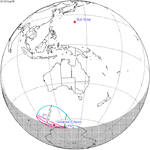 Partial | −1.5101 | ||||
Saros 124
This eclipse is a part of Saros series 124, repeating every 18 years, 11 days, and containing 73 events. The series started with a partial solar eclipse on March 6, 1049. It contains total eclipses from June 12, 1211 through September 22, 1968, and a hybrid eclipse on October 3, 1986. There are no annular eclipses in this set. The series ends at member 73 as a partial eclipse on May 11, 2347. Its eclipses are tabulated in three columns; every third eclipse in the same column is one exeligmos apart, so they all cast shadows over approximately the same parts of the Earth.
The longest duration of totality was produced by member 39 at 5 minutes, 46 seconds on May 3, 1734. All eclipses in this series occur at the Moon’s descending node of orbit.[8]
| Series members 43–64 occur between 1801 and 2200: | ||
|---|---|---|
| 43 | 44 | 45 |
 June 16, 1806 |  June 26, 1824 |  July 8, 1842 |
| 46 | 47 | 48 |
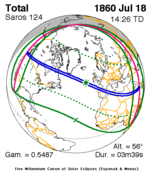 July 18, 1860 | 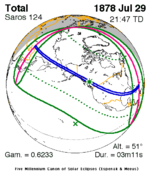 July 29, 1878 |  August 9, 1896 |
| 49 | 50 | 51 |
 August 21, 1914 |  August 31, 1932 |  September 12, 1950 |
| 52 | 53 | 54 |
 September 22, 1968 |  October 3, 1986 |  October 14, 2004 |
| 55 | 56 | 57 |
 October 25, 2022 |  November 4, 2040 |  November 16, 2058 |
| 58 | 59 | 60 |
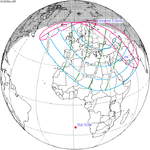 November 26, 2076 |  December 7, 2094 |  December 19, 2112 |
| 61 | 62 | 63 |
 December 30, 2130 |  January 9, 2149 | 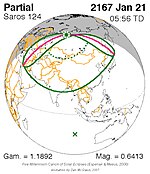 January 21, 2167 |
| 64 | ||
 January 31, 2185 | ||
Metonic series
The metonic series repeats eclipses every 19 years (6939.69 days), lasting about 5 cycles. Eclipses occur in nearly the same calendar date. In addition, the octon subseries repeats 1/5 of that or every 3.8 years (1387.94 days). All eclipses in this table occur at the Moon's descending node.
| 22 eclipse events between March 27, 1884 and August 20, 1971 | ||||
|---|---|---|---|---|
| March 27–29 | January 14 | November 1–2 | August 20–21 | June 8 |
| 108 | 110 | 112 | 114 | 116 |
 March 27, 1884 |  August 20, 1895 | 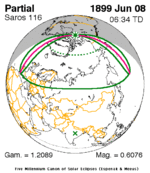 June 8, 1899 | ||
| 118 | 120 | 122 | 124 | 126 |
 March 29, 1903 |  January 14, 1907 |  November 2, 1910 |  August 21, 1914 |  June 8, 1918 |
| 128 | 130 | 132 | 134 | 136 |
 March 28, 1922 |  January 14, 1926 |  November 1, 1929 |  August 21, 1933 |  June 8, 1937 |
| 138 | 140 | 142 | 144 | 146 |
 March 27, 1941 |  January 14, 1945 |  November 1, 1948 |  August 20, 1952 |  June 8, 1956 |
| 148 | 150 | 152 | 154 | |
 March 27, 1960 |  January 14, 1964 |  November 2, 1967 | 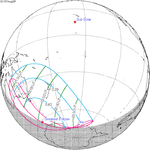 August 20, 1971 | |
Tritos series
This eclipse is a part of a tritos cycle, repeating at alternating nodes every 135 synodic months (≈ 3986.63 days, or 11 years minus 1 month). Their appearance and longitude are irregular due to a lack of synchronization with the anomalistic month (period of perigee), but groupings of 3 tritos cycles (≈ 33 years minus 3 months) come close (≈ 434.044 anomalistic months), so eclipses are similar in these groupings.
| Series members between 1801 and 2200 | ||||
|---|---|---|---|---|
 June 26, 1805 (Saros 114) |  May 27, 1816 (Saros 115) |  April 26, 1827 (Saros 116) | 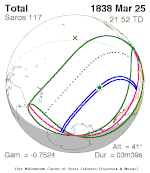 March 25, 1838 (Saros 117) |  February 23, 1849 (Saros 118) |
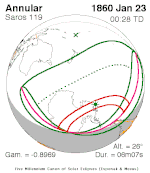 January 23, 1860 (Saros 119) |  December 22, 1870 (Saros 120) | 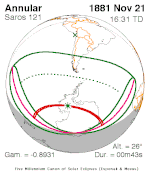 November 21, 1881 (Saros 121) |  October 20, 1892 (Saros 122) |  September 21, 1903 (Saros 123) |
 August 21, 1914 (Saros 124) |  July 20, 1925 (Saros 125) |  June 19, 1936 (Saros 126) |  May 20, 1947 (Saros 127) |  April 19, 1958 (Saros 128) |
 March 18, 1969 (Saros 129) |  February 16, 1980 (Saros 130) |  January 15, 1991 (Saros 131) |  December 14, 2001 (Saros 132) |  November 13, 2012 (Saros 133) |
 October 14, 2023 (Saros 134) |  September 12, 2034 (Saros 135) |  August 12, 2045 (Saros 136) |  July 12, 2056 (Saros 137) |  June 11, 2067 (Saros 138) |
 May 11, 2078 (Saros 139) |  April 10, 2089 (Saros 140) |  March 10, 2100 (Saros 141) | 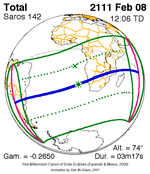 February 8, 2111 (Saros 142) |  January 8, 2122 (Saros 143) |
 December 7, 2132 (Saros 144) |  November 7, 2143 (Saros 145) |  October 7, 2154 (Saros 146) |  September 5, 2165 (Saros 147) |  August 4, 2176 (Saros 148) |
 July 6, 2187 (Saros 149) |  June 4, 2198 (Saros 150) | |||
Inex series
This eclipse is a part of the long period inex cycle, repeating at alternating nodes, every 358 synodic months (≈ 10,571.95 days, or 29 years minus 20 days). Their appearance and longitude are irregular due to a lack of synchronization with the anomalistic month (period of perigee). However, groupings of 3 inex cycles (≈ 87 years minus 2 months) comes close (≈ 1,151.02 anomalistic months), so eclipses are similar in these groupings.
| Series members between 1801 and 2200 | ||
|---|---|---|
 October 20, 1827 (Saros 121) | 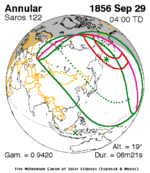 September 29, 1856 (Saros 122) |  September 8, 1885 (Saros 123) |
 August 21, 1914 (Saros 124) |  August 1, 1943 (Saros 125) |  July 10, 1972 (Saros 126) |
 June 21, 2001 (Saros 127) |  June 1, 2030 (Saros 128) |  May 11, 2059 (Saros 129) |
 April 21, 2088 (Saros 130) | 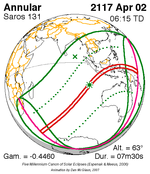 April 2, 2117 (Saros 131) |  March 12, 2146 (Saros 132) |
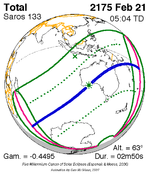 February 21, 2175 (Saros 133) | ||
References
- ^ "August 21, 1914 Total Solar Eclipse". timeanddate. Retrieved 31 July 2024.
- ^ "Moon Distances for London, United Kingdom, England". timeanddate. Retrieved 31 July 2024.
- ^ a b Perrine, Charles D. (1923). "Contribution to the history of attempts to test the theory of relativity by means of astronomical observations". Astronomische Nachrichten. 219 (17): 281–284. Bibcode:1923AN....219..281P. doi:10.1002/asna.19232191706.
- ^ Campbell, W.W.; Curtis, H.D. (1914). "The Lick Observatory-Crocker Eclipse Expedition to Brovarý, Russia". Publications of the Astronomical Society of the Pacific. 26 (156): 225–237. Bibcode:1914PASP...26..225C. doi:10.1086/122351. S2CID 120712519.
- ^ Minniti, Edgardo; Paolantonio, Santiago (2013). "Attempts to prove Einstein's Theory of Relativity" (PDF). Córdoba Estelar. Translated by Cuestas, A.D.; Scorians, E.E.; Valotta, M.E. Córdoba, Argentina: Universidad Nacional de Córdoba. pp. 402–425.
- ^ "Total Solar Eclipse of 1914 Aug 21". EclipseWise.com. Retrieved 31 July 2024.
- ^ van Gent, R.H. "Solar- and Lunar-Eclipse Predictions from Antiquity to the Present". A Catalogue of Eclipse Cycles. Utrecht University. Retrieved 6 October 2018.
- ^ "NASA - Catalog of Solar Eclipses of Saros 124". eclipse.gsfc.nasa.gov.
- Solar eclipse of August 21, 1914 in Russia (Russian) Archived January 2, 2010, at the Wayback Machine
- Earth visibility chart and eclipse statistics Eclipse Predictions by Fred Espenak, NASA/GSFC
- Google interactive map
- Besselian elements
- v
- t
- e
| By era | |
|---|---|
| Saros series (list) | |
| Visibility | |
| Historical |
|

Total/hybrid eclipses
→ next total/hybrid
- 1133
- 1185
- 1560
- 1598
- 1652
- 1654
- 1673
- 1706
- 1715
- 1724
- 1766
- 1778
- 1780
- 1806
- 1816
- 1824
- 1842
- 1851
- 1853
- 1857
- 1858
- 1860
- 1865
- 1867
- 1868
- 1869
- 1870
- 1871
- 1874
- 1875
- 1878
- 1882
- 1883
- 1885
- 1886
- 1887
- Jan. 1889
- Dec. 1889
- 1893
- 1896
- 1898
- 1900
- 1901
- 1903
- 1904
- 1905
- 1907
- Jan. 1908
- Dec. 1908
- 1909
- 1910
- 1911
- Apr. 1912
- Oct. 1912
- 1914
- 1916
- 1918
- 1919
- 1921
- 1922
- 1923
- 1925
- 1926
- 1927
- 1928
- 1929
- Apr. 1930
- Oct. 1930
- 1932
- 1934
- 1936
- 1937
- 1938
- 1939
- 1940
- 1941
- 1943
- Jan. 1944
- 1945
- 1947
- 1948
- 1950
- 1952
- 1954
- 1955
- 1956
- 1957
- 1958
- 1959
- 1961
- 1962
- 1963
- 1965
- 1966
- 1967
- 1968
- 1970
- 1972
- 1973
- 1974
- 1976
- 1977
- 1979
- 1980
- 1981
- 1983
- 1984
- 1985
- 1986
- 1987
- 1988
- 1990
- 1991
- 1992
- 1994
- 1995
- 1997
- 1998
- 1999
- 2001
- 2002
- 2003
- 2005
- 2006
- 2008
- 2009
- 2010
- 2012
- 2013
- 2015
- 2016
- 2017
- 2019
- 2020
- 2021
- 2023
- 2024
- → 2026
- 2027
- 2028
- 2030
- 2031
- 2033
- 2034
- 2035
- 2037
- 2038
- 2039
- 2041
- 2042
- 2043
- 2044
- 2045
- 2046
- 2048
- 2049
- 2050
- 2052
- 2053
- 2055
- Jan. 2057
- Dec. 2057
- 2059
- 2060
- 2061
- 2063
- 2064
- 2066
- 2067
- 2068
- 2070
- 2071
- 2072
- 2073
- 2075
- 2076
- 2077
- 2078
- 2079
- 2081
- 2082
- 2084
- 2086
- 2088
- 2089
- 2090
- 2091
- 2093
- 2094
- 2095
- 2096
- 2097
- 2099
- 2100
- 2186

Annular eclipses
→ next annular
- 1820
- 1854
- 1879
- 1889
- 1900
- 1901
- 1903
- 1904
- 1905
- 1907
- 1908
- 1911
- 1914
- Feb. 1915
- Aug. 1915
- 1916
- 1917
- 1918
- 1919
- 1921
- 1922
- 1923
- 1925
- 1926
- 1927
- 1929
- 1932
- Feb. 1933
- Aug. 1933
- 1934
- 1935
- 1936
- 1937
- 1939
- 1940
- 1941
- 1943
- Jul. 1944
- 1945
- 1947
- 1948
- 1950
- Mar. 1951
- Sep. 1951
- 1952
- Jan. 1954
- Dec. 1954
- 1955
- 1957
- 1958
- 1959
- 1961
- 1962
- 1963
- 1965
- 1966
- Mar. 1969
- Sep. 1969
- 1970
- 1972
- Jan. 1973
- Dec. 1973
- 1976
- 1977
- 1979
- 1980
- 1981
- 1983
- 1984
- 1987
- 1988
- 1990
- 1991
- 1992
- 1994
- 1995
- 1998
- 1999
- 2001
- 2002
- 2003
- 2005
- 2006
- 2008
- 2009
- 2010
- 2012
- 2013
- 2014
- 2016
- 2017
- 2019
- 2020
- 2021
- 2023
- → 2024
- 2026
- 2027
- 2028
- 2030
- 2031
- 2032
- 2034
- 2035
- 2036
- Jan. 2038
- Jul. 2038
- 2039
- 2041
- 2042
- 2043
- 2044
- 2045
- 2046
- 2048
- 2049
- 2052
- 2053
- Jan. 2056
- Jul. 2056
- 2057
- 2059
- 2060
- 2061
- 2063
- 2064
- 2066
- 2067
- 2070
- 2071
- Jan. 2074
- Jul. 2074
- 2075
- 2077
- 2078
- 2079
- 2081
- 2082
- 2084
- Jun. 2085
- Dec. 2085
- 2088
- 2089
- Feb. 2092
- Aug. 2092
- 2093
- 2095
- 2096
- 2097
- 2099
- 2100

Partial eclipses
→ next partial
- Jan. 1639
- Apr. 1902
- May 1902
- Oct. 1902
- Feb. 1906
- Jul. 1906
- Aug. 1906
- Dec. 1909
- Nov. 1910
- Apr. 1913
- Aug. 1913
- Sep. 1913
- Dec. 1916
- Jan. 1917
- Jun. 1917
- Jul. 1917
- May 1920
- Nov. 1920
- Mar. 1924
- Jul. 1924
- Aug. 1924
- Dec. 1927
- Jun. 1928
- Nov. 1928
- Apr. 1931
- Sep. 1931
- Oct. 1931
- Jan. 1935
- Feb. 1935
- Jun. 1935
- Jul. 1935
- Nov. 1938
- Mar. 1942
- Aug. 1942
- Sep. 1942
- Jan. 1946
- May 1946
- Jun. 1946
- Nov. 1946
- Apr. 1949
- Oct. 1949
- Feb. 1953
- Jul. 1953
- Aug. 1953
- Dec. 1956
- Mar. 1960
- Sep. 1960
- Jan. 1964
- Jun. 1964
- Jul. 1964
- Dec. 1964
- May 1967
- Mar. 1968
- Feb. 1971
- Jul. 1971
- Aug. 1971
- Dec. 1974
- May 1975
- Nov. 1975
- Apr. 1978
- Oct. 1978
- Jan. 1982
- Jun. 1982
- Jul. 1982
- Dec. 1982
- May 1985
- Apr. 1986
- Mar. 1989
- Aug. 1989
- Dec. 1992
- May 1993
- Nov. 1993
- Apr. 1996
- Oct. 1996
- Sep. 1997
- Feb. 2000
- 1 Jul. 2000
- 31 Jul. 2000
- Dec. 2000
- Apr. 2004
- Oct. 2004
- Mar. 2007
- Sep. 2007
- Jan. 2011
- Jun. 2011
- Jul. 2011
- Nov. 2011
- Oct. 2014
- Sep. 2015
- Feb. 2018
- Jul. 2018
- Aug. 2018
- Jan. 2019
- Apr. 2022
- Oct. 2022
- → Mar. 2025
- Sep. 2025
- Jan. 2029
- Jun. 2029
- Jul. 2029
- Dec. 2029
- 2032
- 2033
- Feb. 2036
- Jul. 2036
- Aug. 2036
- 2037
- May 2040
- Nov. 2040
- Jan. 2047
- Jun. 2047
- Jul. 2047
- Dec. 2047
- 2050
- Apr. 2051
- Oct. 2051
- Mar. 2054
- Aug. 2054
- Sep. 2054
- 2055
- May 2058
- Jun. 2058
- Nov. 2058
- Mar. 2062
- Sep. 2062
- Feb. 2065
- Jul. 2065
- Aug. 2065
- Dec. 2065
- 2068
- Apr. 2069
- May 2069
- Oct. 2069
- 2072
- 2073
- Jun. 2076
- Jul. 2076
- Nov. 2076
- Feb. 2083
- Jul. 2083
- Aug. 2083
- 2084
- 2086
- May 2087
- Jun. 2087
- Oct. 2087
- 2090
- 2091
- Jun. 2094
- Jul. 2094
- Dec. 2094
- Apr. 2098
- Sep. 2098
- Oct. 2098
 Astronomy portal
Astronomy portal Solar System portal
Solar System portal Category
Category














